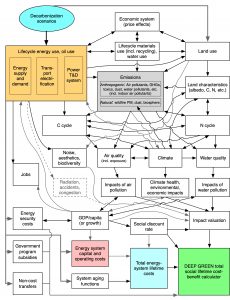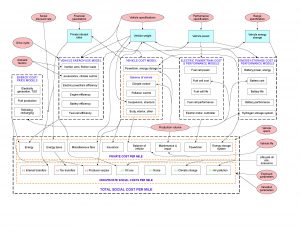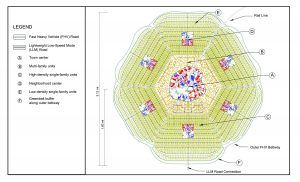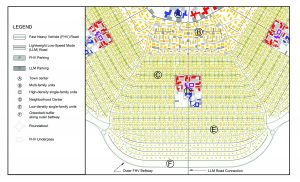JUMP TO:
100% WWS – wind, water, and solar power
Social cost-benefit analysis of energy use and motor-vehicle use
IMSSA – Integrated Modeling Systems and Scenario Analysis
AVCEM — the Advanced Vehicle Cost and Energy-Use Model
Design and analysis of a sustainable transportation-infrastructure town plan
DEEP GREEN – Detailed Environmental and Economic Projections for Global Renewable Energy and Emissions sceNarios
Although there are many studies of deep-decarbonization of energy systems, and many studies of the environmental impacts of deep decarbonization, there is no existing research or modeling system that accounts for all – or even most – of the elements needed for a complete, detailed, internally consistent analysis of the full social costs and benefits of deep-decarbonization scenarios for all energy-use sectors in the world. DEEP GREEN will fill these gaps by creating a novel, comprehensive, integrated framework including lifecycle use of energy, materials, and water; detailed treatment of transportation electrification; a model of the electricity transmission and distribution system; land use; economy-wide price effects, with feedbacks between prices, energy use, and materials use; emissions, including anthropogenic air pollutants and greenhouse gases, natural emissions, and water pollutants; surface albedo; the nitrogen (N) cycle; the carbon (C) cycle; air quality; climate change, with feedbacks to air quality and emissions; water quality; health, environmental, and economic impacts; noise and impacts on aesthetics and biodiversity; impact valuation; energy security; jobs; energy-system costs, incorporating explicit system aging functions; government program subsidies; non-cost transfers; and total social lifetime costs and benefits.
DEEP GREEN will include all energy-use sectors (residential, commercial, industrial, transportation, agriculture/forestry/fishing, other) and a diverse portfolio of energy technologies (solar, wind, hydro, geothermal, nuclear, bioenergy, fossil fuels, carbon capture and sequestration, and more). It will address under-explored technical and economic research questions regarding energy resources, new energy technologies, energy transmission and distribution, land use, energy/economic-system interactions, C-cycle/N-cycle/air-quality interactions, the electrification of the transportation sector, and more. Because DEEP GREEN will be the most comprehensive tool of its kind, it will provide the most scientifically sound basis for measurably improving economic, social, and environmental well-being related to the production and use of energy.
DEEP GREEN is the culmination of my major research projects on 100% WWS, social cost, and IMSSA.
Planned research projects:
• Develop, document, and run DEEP GREEN, to estimate of the lifecycle environmental, health, and energy-security impacts and social costs and benefits of deep-decarbonization scenarios, with detailed understanding of the risks and benefits of slow-to-rapid transitions to 80% to 100% decarbonization, and identification of the most robust, sustainable, low-cost strategies.
• Release of publicly available, open-source DEEP GREEN modeling system.
Much of the planned research work for DEEP GREEN is described under the sections on 100% WWS, social costs, and IMSSA.
An illustration of the proposed DEEP GREEN modeling system:

100% WWS – wind, water, and solar power
This work, led by Mark Jacobson of Stanford, features technological, environmental, economic, and performance analyses of providing all energy for all sectors of the economy entirely from wind, water, or solar power. These analyses have attracted attention from academia, governments, and businesses around the world, and have been featured in news programs, international conferences, government policy making, documentaries, and other media.
Current research projects:
• A detailed model of the costs and benefits of phasing in 100% WWS in all energy sectors in all 50 states of the U.S.
My work here will be subsumed under the DEEP GREEN project.
Social cost-benefit analysis of energy use and motor-vehicle use
This research quantifies the dollar value of the private and external costs of energy use and motor-vehicle use, with particular attention to accidents, congestion, oil use, and impacts on human health, crops, visibility, noise, and global climate. The major environmental external costs are estimated with detailed damage-function models involving estimates of emissions, exposure, dose-response functions, and valuation. This social cost work is widely regarded as the most detailed and- comprehensive effort in the U. S. in the past 40 years. Sessions at two academic conferences have been devoted to discussing my social cost-benefit research.
Current research projects:
• Update of dose-response, exposure, and valuation functions.
• Theoretical and empirical analysis of the social discount rate.
• Revision of estimates of the marginal external costs of motor-vehicle accidents.
• Revision of estimates of the costs of goods and services bundled in the private sector.
• Estimation of oil and gasoline supply curves for the U.S. and the world.
• Detailed model of oil-supply strategies for major global oil producers, with endogenous feedback of demand-side response on profit-maximizing quantity decisions.
• Reduced-form version of climate-change damage-function models.
• Revised, updated treatment of the formation of secondary organic aerosols.
• Continued development of the Social Cost Calculator (SCC), which provides comprehensive estimates of the social cost of transportation-policy scenarios.
Much of this work will be used in the DEEP GREEN project.
IMSSA – Integrated Modeling Systems and Scenario Analysis
IMSSA combines Integrated Assessment Modeling (IAM) and Lifecycle Analysis (LCA) to estimate the climate and air-pollution impacts of emissions of greenhouse gases and criteria pollutants from the lifecycle of wide range of conventional and alternative energy systems. IMSSA builds upon the Lifecycle Emissions Model (LEM), using the LEM’s core life-cycle representations in an expanded structure that includes new models of environmental and economic systems.
The LEM analyzes emissions of greenhouse gases and criteria pollutants from the lifecycle of passenger and freight transport, materials, electricity, and heating and cooking. The LEM includes the use of transportation fuels (with a wide range of alternative vehicles and fuels), transportation modes (light-duty vehicles, heavy-duty vehicles, off-road vehicles, buses, light rail, heavy rail, bicycles), major materials (such as steel, aluminum, and plastics), electricity generation and use, and fuels for heating and cooking. The LEM represents international flows of major commodities, and can provide detailed analyses and outputs for up to different 30 countries. The LEM and the reports generated from it have been used by the U. S. Department of Energy, the U. S. National Research Council, the Intergovernmental Panel on Climate Change, the Canadian government, and the White House “Car Talk” advisory Committee. The LEM is the conceptual forefather of the more widely known GREET model at Argonne National Laboratory, and is the basis of Canada’s GHGenius Model.
Current IMSSA research projects:
• Development of simple models of the carbon cycle and the thermal inertia of the oceans.
• Analysis of the effects of ozone on soil carbon and plant carbon.
• Comprehensive model of the nitrogen cycle as it affects emissions of air pollutants and greenhouse gases.
• Development of a simplified, regional-to-global model of emissions, dispersion, atmospheric chemistry, radiative forcing, and temperature change.
• Estimation of CO2-equivalency factors for all atmospheric pollutants, based on the present value of climate-change and air-pollution damages.
• Updating emission factors, energy-use projections, technology characterizations, parameterizations for individual countries.
• Detailed model of the lifecycle of materials with explicit accounting of recycling.
• Incorporation of price-dynamic economic effects of transportation policies on the use of fuels and electricity.
• More detailed representation of the spatial and temporal variation in the carbon characteristics of ecosystems.
• Delineation of the conceptually correct counterfactual for understanding the climate impacts of biofuels policies targeted at using “marginal” or “degraded” land.
Most of this work will be incorporated, typically in reduced form, into DEEP GREEN.
AVCEM — the Advanced Vehicle Cost and Energy-Use Model
AVCEM combines models of vehicle performance, energy use, manufacturing cost, and external costs to produce detailed estimates of the full social lifetime costs of advanced battery, fuel-cell, and hybrid electric vehicles and gasoline and alternative-fuel internal-combustion-engine vehicles. It has a detailed second-by-second energy-use simulation, a full accounting of variable manufacturing cost and multiple levels of fixed “overhead” costs (such as corporate-level costs), detailed treatment of all operating and maintenance costs, and simplified estimates of the external costs of air pollution, climate change, and energy use. It simultaneously designs a vehicle to satisfy a particular driving mission and calculates the full social lifetime cost of the designed vehicle. AVCEM is the most detailed integrated model of energy-use, performance, manufacturing cost, and lifecycle costs of its kind.
Current or planned research projects:
• Comprehensive, detailed review of existing literature on the lifetime cost of advanced electric vehicles (EVs).
• Integrated model of the cost, performance, and lifetime of EV batteries.
• Integrated model of the cost, performance, and lifetime of fuel cells.
• Analysis of retail cost vs. manufacturing cost.
• Analytical model of the energy use of internal-combustion engines (ICEs).
• Validation of EV second-by-second energy-use model against real-world data.
• External costs of life-cycle air-pollution, climate-change, and oil-use impacts.
• Costs and benefits of vehicle-to-grid (V2G) and second-life use of EV batteries.
• Cost of electrolytic-hydrogen refueling stations integrated with a renewable power grid.
• Analyses of consumer and social lifetime cost of EVs and alternative-fuel ICEVs.
An illustration of the AVCEM modeling system:

Design and analysis of a sustainable transportation-infrastructure town plan
This research features a novel proposal for a new town plan with a dual-road network that separates motorized traffic by kinetic-energy levels: one road system serves conventional fast, heavy motor-vehicles, and another serves only lightweight, low-speed modes (including both motorized and non-motorized modes). The plan significantly reduces air pollution, congestion, energy-use, greenhouse-gas emissions, and accidents, and improves mobility, without increasing cost or requiring people to drive less or give up low-density suburban living.
Planned research projects:
• Investigation of household responses to features of the new plan.
An illustration of the whole city plan:

An illustration of a neighborhood branch:

